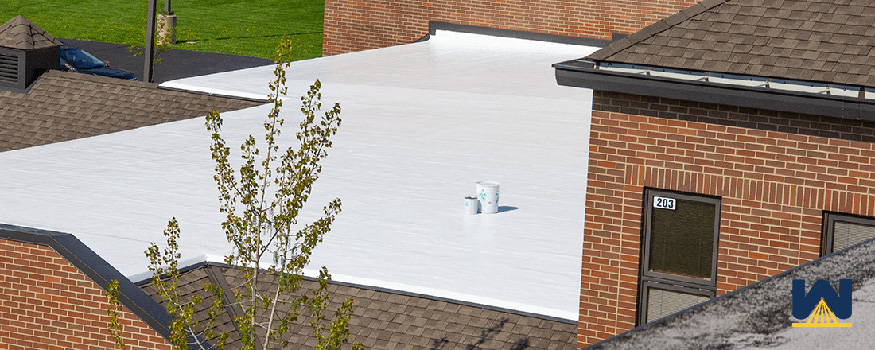When we meet with building supervisors at school districts, they’re usually stuck on one roofing system…TPO. When we bring up SPF (Spray Polyurethane Foam), they have some questions:
- What is spray foam roofing? (I’ve never heard of this roofing system before)
- Is spray foam roofing more cost-effective than TPO?
- Which roofing system provides better insulation?
- Which system is faster to apply?
- Which is better on Tectum?
At West Roofing Systems, we want to make sure that building supervisors have the best information available. For this reason, we created an article that explores the differences between TPO and SPF roofing systems that’ll give you all the information you need in choosing the best roof for your schools.
The Basics
TPO
Thermoplastic Polyolefin (TPO) is a single-ply roofing membrane that is one of the fastest-growing commercial roofing systems on the market. TPO roofing systems are made up of a single layer of synthetics and reinforcing scrim that can be used to cover flat roofs. The scrim is heated with a hot air gun that welds the seams together.
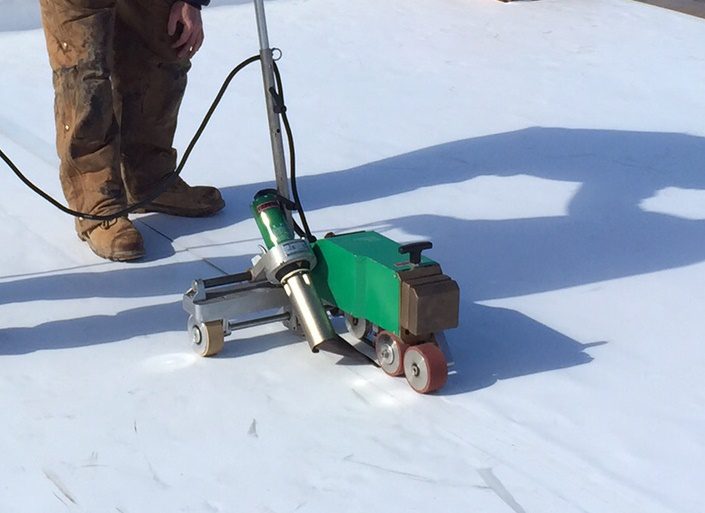
TPO membranes are manufactured in sheets that are 10, 12, or 20 feet wide. TPO has gained industry acceptance with the white-colored, natural, reflective surface to reflect UV rays.
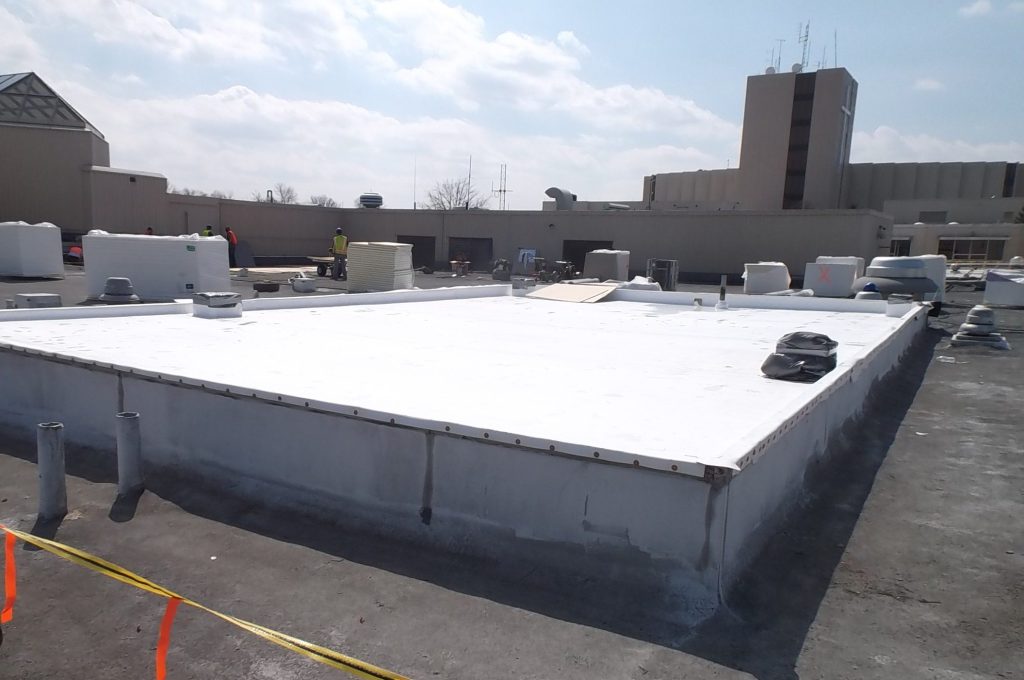
Spray Polyurethane Foam
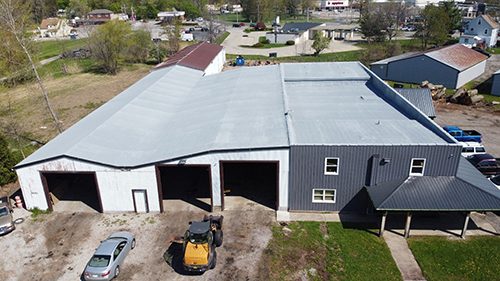
Spray Polyurethane Foam (SPF) is a combination of two chemicals that are heated and pressurized to spray as a liquid, which expands into a foam, and creates a solid layer across an existing roof.
Quick fact: SPF grows to 30x its size in 8 seconds…and you can walk on it in about one minute.
While SPF roofing is not the most known type of roofing material, the technology has been around since the early 1960s. An SPF roofing system can be used in any climate, and when correctly installed and maintained, can last over 50 years.
TPO vs Spray foam – which is more cost-effective?
For an average 20,000 sq. foot roof, it will usually cost between $5 and $10 per square foot in materials and labor to install a typical spray foam roofing system. This price range is for a spray foam roof of average thickness and building structure.
An average 20,000 sq. foot roof usually costs between $5 and $10 per square foot in materials and labor to install a typical TPO roofing system.
NOTE: Pricing depends on variables such as:
- Does the existing roof need to be removed?
- Do cover boards need to be installed?
- Are there any existing penetrations?
- How accessible is the roof?
- Any much more…
An important aspect that commonly gets thrown to the back-burner is the lifetime costs of each system.
A spray foam roof is a renewable roofing system. In 10-20 years (whichever warranty you choose with your spray foam roof), the roof is simply cleaned, spot repairs (if any) are made, and then coating is installed onto the roof.
A recoat on a spray foam roof costs 1/2 to 1/3 of the original cost of the installation. Once the recoat is complete, a new 10, 15, or 20-year warranty is granted.
For example, on a 15-year warranted spray foam roof, 25 mils of coating will be installed to protect the spray foam from UV rays, debris, foot traffic, etc. At year 16, the initial 25 mils of coating will wear away naturally to around 7-8 mils of coating.
Once the roof is cleaned and prepped, a spray foam contractor will bring the coating back up to 25 mils, and then a new 15-year warranty will be granted.
This is entirely different on a TPO roof.
At the end of a TPO roof’s lifetime, there is no option to renew the roof. The only option is to rip all the TPO off, transport all the materials to a landfill, replace the saturated insulation (if there is any), and install new TPO over the entire roof.
A new TPO roof will cost 100% of the original cost of the installation.
TPO vs Spray foam roofing: Which roofing type is better for insulation?
Spray foam has many advantages over other roofing systems. One advantage is that it provides schools with more efficient insulation. This is important because HVAC costs can be high when trying to keep hundreds of students and faculty comfortable.
With spray foam being seamless, it has an R-value of 6.5 per inch (the highest rating of any standard roofing insulation) vs TPO, which provides no insulation value.
TPO vs Spray foam: Which roofing system is faster to apply?
Speed is greatly important for school roofing projects. Schools only have 12 weeks of summer vacation without any students or staff around.
With unpredictable weather and roofing contractors scheduling jobs 2-3 months in advance, schools need to make sure the contractor can finish the job before school begins.
One factor that can increase the speed of a project is the type of material being laid down.
Quick fact: Spray polyurethane foam can be installed 50% faster than TPO.
This is because spray foam is “spray-applied”. There is no cutting around penetrations or any custom-fitting around flashings.
A 20,000 square foot school, with spray foam being laid down around 3,000 sq. ft/day, that’s a 6.6-day project.
For TPO, the same project can take around 13.2 days. Add in a few rainouts and your project can take 2-3 weeks.
NOTE: Shortening the project in half saves tremendously on labor costs.
TPO vs Spray foam roofing: Which system is better on Tectum?
If you’re a building supervisor at a school district, I’m sure you know about tectum. Tectum is the type of decking material that makes up most school roofs. Schools especially use tectum over a gym because it’s great for sound control and acoustics.
So which roofing option is better on tectum?
It’s spray foam, and here’s why.
Spray foam allows a contractor to tear off the old roof, get down to the tectum, and spray the foam overtop. No penetrations will be made.
With TPO, a contractor will have to fasten the TPO down with traditional plates and auger style screws, making penetrations in the tectum roof deck. Adhesive TPO is available over Tectum but will have a significant impact on cost.
TPO vs Spray foam roofing: Who wins?
The key takeaways are:
- TPO is slightly cheaper initially, but more costly over the lifetime of the building.
- Spray foam provides better insulation which reduces energy costs
- A spray foam roof can be applied 50% faster
- Spray foam is better on tectum (no penetrations)
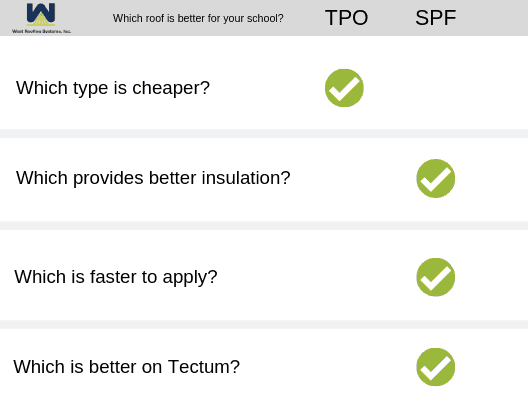
Want to learn more about spray foam roofing? Please view our easy to digest cheat sheet!

